thermoregulation
Weather cools down, but seal pup activity heats up
Oct/17/13 07:25 PM
Just as fall weather has turned very brisk, so has the number of seal pup responses along West Seattle’s shoreline. There has been a noticeable increase in activity the past week or so. According to Seal Sitters volunteer Richard, an avid diver, he has been seeing more bait balls of the small forage fish that are indispensable to the marine ecosystem and a favorite food of seal pups (read more about forage fish here). Last evening until just after dark, Richard and fellow volunteer Suzanne looked over new pup Humphrey who snoozed below Beach Drive. A very tiny pup, Humphrey could stand to snack on some of those fish and pack on some blubber to keep him warm in Puget Sound’s frigid waters. He returned to the water sometime overnight.
Seal pup Tiger continues his/her routine of hauling out just around dark every evening on the Elliott Bay side of West Seattle. He is thriving and it is a joy for volunteers to see such a seemingly healthy, vigorous pup. Tiger does seal pup yoga on the smooth beach sand, stretching his tail high and curving his body into a “u” shape - the classic “banana pose”. This behavior is his way of circulating warmth - or thermoregulating his temperature.
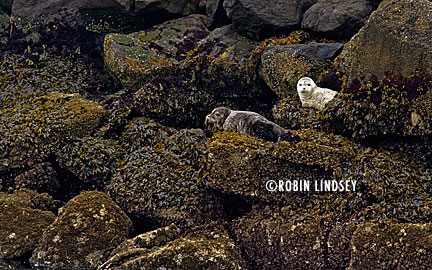 On a somewhat unusual note, for the past two days (possibly more that we were unaware of) pups have been hanging out together on the rocks along one of the sea walls. These young harbor seals come in at high tide during the night and are left quite vulnerable resting on the jagged rocks far above the water level, where they wait for the tide to return.
On a somewhat unusual note, for the past two days (possibly more that we were unaware of) pups have been hanging out together on the rocks along one of the sea walls. These young harbor seals come in at high tide during the night and are left quite vulnerable resting on the jagged rocks far above the water level, where they wait for the tide to return.
Each morning, responders have taped off the area above them so that they can rest undisturbed and not be at risk for fall and potential injury. Despite this, on Tuesday morning a woman went under the tape clearly marked with a “Do Not Enter” sign, standing a few yards from the pups and refused to leave, asking what harm she was doing. We tried to explain to her that there was a very real danger to these pups if they were scared and tumbled down 15 feet of craggy rocks with deep holes (seal pups Henry and Spanky fell deep into holes in past seasons).This is, of course, beside the fact that going under the tape and disturbing a maine mammal is breaking a federal law, the Marine Mammal Protection Act (read more here). It was quite sad that this woman created a contentious scene over our efforts to give these pups some rest. The pups could easily be seen from a sidewalk viewpoint and the posted signs explained that seal pups need undisrupted, stress-free rest to survive against challenging odds - a 50% mortality. People standing too close is most definitely a source of stress, which has been proven in many studies to negatively impact health in humans and animals. Thankfully, unpleasant incidents are rare. Most people are thrilled and empowered to be able to help a pup survive by simply giving them space.
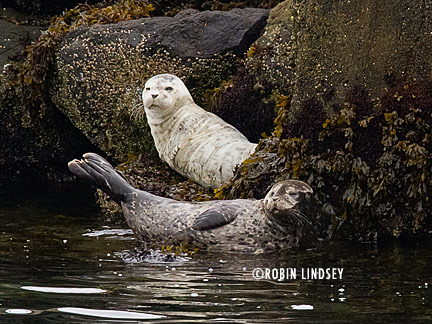 Volunteers set up a viewing scope so that the public could get an exceptionally close view of the pups, one with a beautiful light coat and the other with luxurious dark fur. It was a fantastic opportunity for passersby to learn about seal pup biology and behavior. The two pups returned to Elliott Bay mid-afternoon Tuesday when the tide finally reached them (photo right). The body weight of these two weaner pups seems to reflect that there is indeed more of a food source out there and we’ve observed quite a few pups fishing offshore. Most often, a pup will haul out close to where he is foraging.
Volunteers set up a viewing scope so that the public could get an exceptionally close view of the pups, one with a beautiful light coat and the other with luxurious dark fur. It was a fantastic opportunity for passersby to learn about seal pup biology and behavior. The two pups returned to Elliott Bay mid-afternoon Tuesday when the tide finally reached them (photo right). The body weight of these two weaner pups seems to reflect that there is indeed more of a food source out there and we’ve observed quite a few pups fishing offshore. Most often, a pup will haul out close to where he is foraging.
Yesterday morning before dawn, two light-coated pups were resting in almost the same spot. Unfortunately, as daylight increased, so did their nerves. The first jittery pup scooted back down the rocks to get to the water, tumbling the last few feet before landing in the bay with a big splash. This prompted the other pup to follow suit, disappearing in a watery splat.
These pups, only 2-3 months old, are now on their own with no adult to protect them. There is certainly safety in numbers for newly weaned pups; while one catches a snooze the other can be on the alert, providing a more satisfying rest. In all, Seal Sitters responded to 4 pups in West Seattle yesterday, with 3 the day before. We are comparing distinct markings to determine if the pups on the rocks are new visitors to our shores and will update Blubberblog with our findings.
Seal pup Tiger continues his/her routine of hauling out just around dark every evening on the Elliott Bay side of West Seattle. He is thriving and it is a joy for volunteers to see such a seemingly healthy, vigorous pup. Tiger does seal pup yoga on the smooth beach sand, stretching his tail high and curving his body into a “u” shape - the classic “banana pose”. This behavior is his way of circulating warmth - or thermoregulating his temperature.

Each morning, responders have taped off the area above them so that they can rest undisturbed and not be at risk for fall and potential injury. Despite this, on Tuesday morning a woman went under the tape clearly marked with a “Do Not Enter” sign, standing a few yards from the pups and refused to leave, asking what harm she was doing. We tried to explain to her that there was a very real danger to these pups if they were scared and tumbled down 15 feet of craggy rocks with deep holes (seal pups Henry and Spanky fell deep into holes in past seasons).This is, of course, beside the fact that going under the tape and disturbing a maine mammal is breaking a federal law, the Marine Mammal Protection Act (read more here). It was quite sad that this woman created a contentious scene over our efforts to give these pups some rest. The pups could easily be seen from a sidewalk viewpoint and the posted signs explained that seal pups need undisrupted, stress-free rest to survive against challenging odds - a 50% mortality. People standing too close is most definitely a source of stress, which has been proven in many studies to negatively impact health in humans and animals. Thankfully, unpleasant incidents are rare. Most people are thrilled and empowered to be able to help a pup survive by simply giving them space.

Yesterday morning before dawn, two light-coated pups were resting in almost the same spot. Unfortunately, as daylight increased, so did their nerves. The first jittery pup scooted back down the rocks to get to the water, tumbling the last few feet before landing in the bay with a big splash. This prompted the other pup to follow suit, disappearing in a watery splat.
These pups, only 2-3 months old, are now on their own with no adult to protect them. There is certainly safety in numbers for newly weaned pups; while one catches a snooze the other can be on the alert, providing a more satisfying rest. In all, Seal Sitters responded to 4 pups in West Seattle yesterday, with 3 the day before. We are comparing distinct markings to determine if the pups on the rocks are new visitors to our shores and will update Blubberblog with our findings.
Seal yoga class at Alki today
May/28/13 10:40 PM
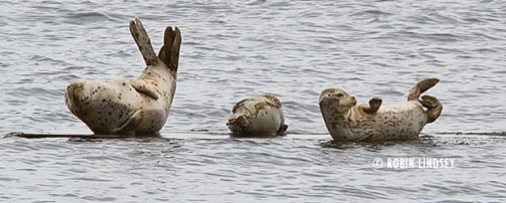
Soon, a new wave of seal pups will be born in South Puget Sound as pupping season gets underway in mid-late June. We could start seeing some of these new pups on West Seattle’s shores as early as July. There was an unconfirmed report of a premature pup at Ballard’s Golden Gardens recently. The high season for seal pups in West Seattle is Fall. As always, if you come across a pup onshore, stay back and call Seal Sitters’ hotline at 206-905-7325 (SEAL).
Rafting sea lions spark calls of concern
Feb/07/11 09:29 PM
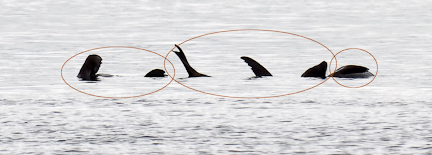
West Seattle seal pup festival - four pups on the beach
Nov/06/10 09:24 PM

Happiness is a warm dock
May/18/10 11:24 PM
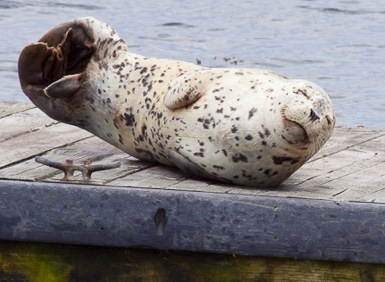
A very alert male seal enjoyed the warm sun at the newest pinniped hot spot: the boat ramp. Here he is shown thermoregulating a bit, stretching and curling his flippers and tail. Comparison of markings have identified him as the same seal that had a bloody wound on May 4th. It was not possible today to see the spot where the wound had been located. It is encouraging that he was so animated and appeared generally healthy, but was still a bit too thin (although you’d never guess it from this photo).
Barricades were placed at the entrance to each dock with information about the Marine Mammal Protection Act and seal behavior, warning the public to give him space to rest. We’ll keep an eye out for him tomorrow in hopes of seeing if the wound has fully healed. Should you see him on the ramp or elsewhere on shore, please call dispatch @ 206-905-7325 (SEAL).
(update May 21, 1 pm)
This seal has been returning to the boat ramp for rest over the past two days. There is no longer any evidence of blood on his right hip, so that older wound has apparently healed. There is, however, some blood this afternoon near the joint of his left flipper. It‘s really tough out there for a wild animal - foraging for prey and being a prey animal yourself. All the more reason for people to keep their distance so he can snooze and gain strength. Hopefully, this skinny guy will pack on some pounds!
"Sailing" sea lion sparks concern
Feb/21/10 07:55 PM
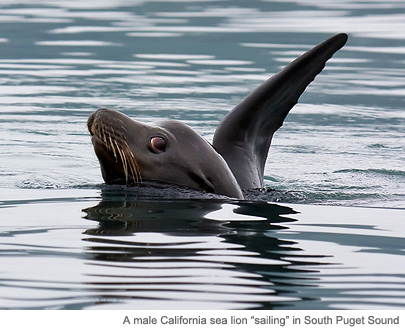
So, what exactly is thermoregulation? Sea lions and other pinnipeds have a system of veins and arteries that transfer heat to the rest of their bodies and organs. By extending their flippers out of the water, the blood in that less insulated part of the body absorbs heat from the sun or warmer air, and circulates it through the body to their internal organs. Conversely, on a hot day, you may see a sea lion with flippers to the wind, cooling the blood which then circulates and reduces body temperature. Read more about sea lions on our website.







